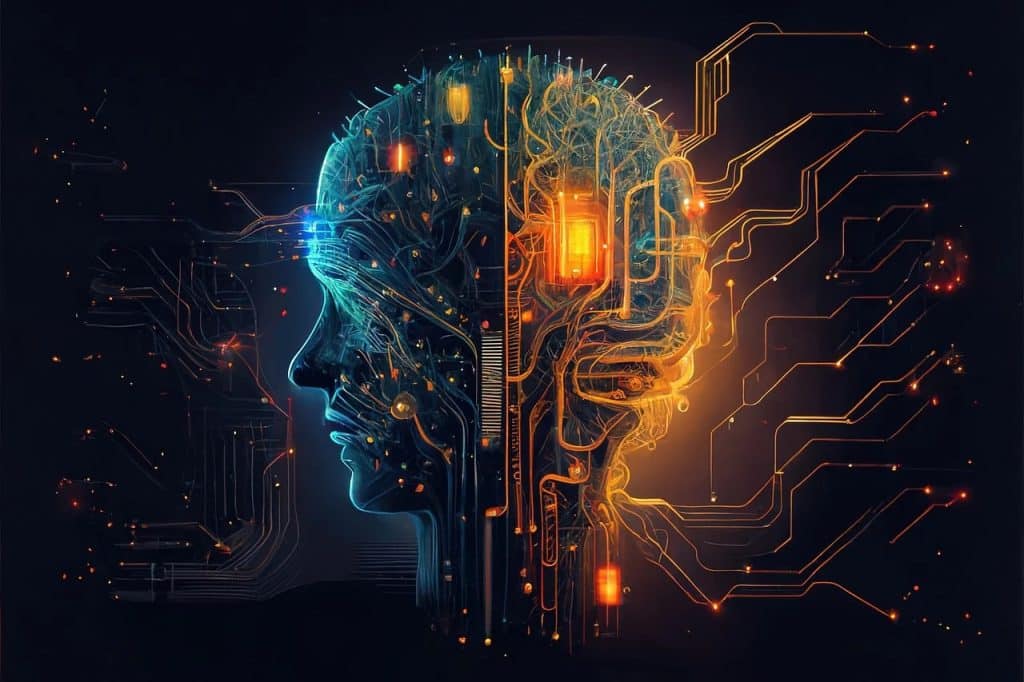
AI is much more than a buzzword these days. ChatGPT’s rapid growth and adoption is just one example of how quickly the field is advancing and how the technology can add value to your organization.
To give you another example, Metaverse’s integration with Generative AI has the potential to create huge opportunities and to transform your ideas into content and experiences. We’ll soon share an article on the Metaverse statistics – but for now, let’s dive into the latest AI statistics and the details of how the sector is changing the world.
AI Trends for 2023
One of the top AI trends for 2023 is the area of AI ethics. Concerns about ethical conduct are widespread today and are driving the adoption of related legislation worldwide, including in the EU and the US.
Another major AI trend for 2023 is its widespread cross-industry adoption. AI concepts like digital twins, automation, and CX personalization are driving adoption on an unprecedented scale in real-world industry and digital business.
Lastly, we can’t talk about the top AI trends for 2023 without mentioning OpenAI. ChatGPT, GPT-3.5, and GPT-4 are types of Generative AI, which is a very big trend for 2023. ChatGPT’s success is evidence of the huge breadth of B2B and B2C use cases for NLP-driven Generative AI. The platform already has over 100 million users.
We’ll now take a closer look at these AI trends and some others.
Increased Adoption of AI in Industries
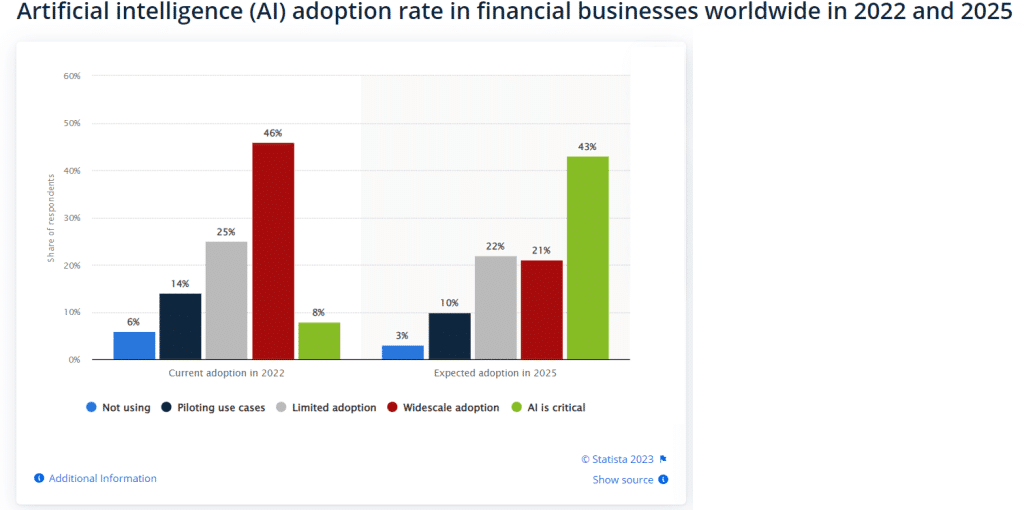
Source: Statista
Thanks to increased cross-industry AI adoption, it’s expected to have an annual growth rate of 37.3% from 2023 to 2030. And its market impact is estimated to contribute a 21% net increase to American GDP by 2030.
The highest rates of AI adoption are predicted to be in the healthcare, finance, and manufacturing industries. Here are some examples of AI implementation:
| Industry | Example |
| Automotive | By 2030, one in ten cars will be self-driving. |
| Manufacturing | Digital twins will be used to create components and predict performance. |
| Retail | AI-powered forecasts will reduce supply chain management errors by 20-50%. |
| Healthcare | AI-powered medical imaging will help detect skin cancer. |
| Finance | Generative AI will simulate market conditions to provide insights based on different variables. |
Advancements in Natural Language Processing (NLP)
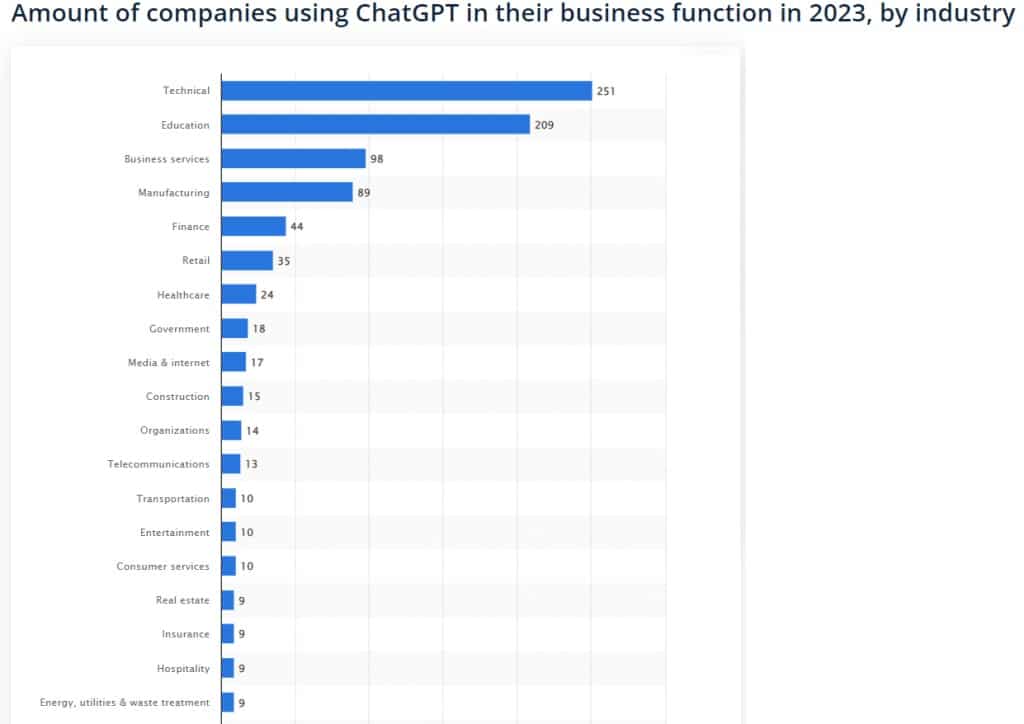
Source: Statista
By 2028, the NLP market is forecast to exceed $126.2 billion.
That’s no surprise, though – ChatGPT broke all NLP records by reaching 1 million users in the first five days of its release. And with the release of the ad-free ChatGPT iOS app, the number of users will only grow.
Indeed, the emergence of language models like GPT-3.5 and GPT-4 gives rise to many potential use cases. And with GPT-4’s enhanced understanding of images and dialects, B2B and B2C use cases are truly endless. Here are some possibilities:
| GPT-3.5 | GPT-4 |
| Content generation | AI-generated business videos via image outputs |
| Customer chatbots and personalization | Creation and improvement of code |
| Complex data analytics | Website creation based on images |
| Translation of industry-specific texts | Solution of complex equations and chemical reactions |
| Generation of recipes based on pictures of a user’s fridge |
Investors are taking note of the NLP trend. In 2022, twelve companies in the NLP space, including Grammarly and Verbit, received VC funding of over $200 million.
Ethical AI & Responsible AI Development
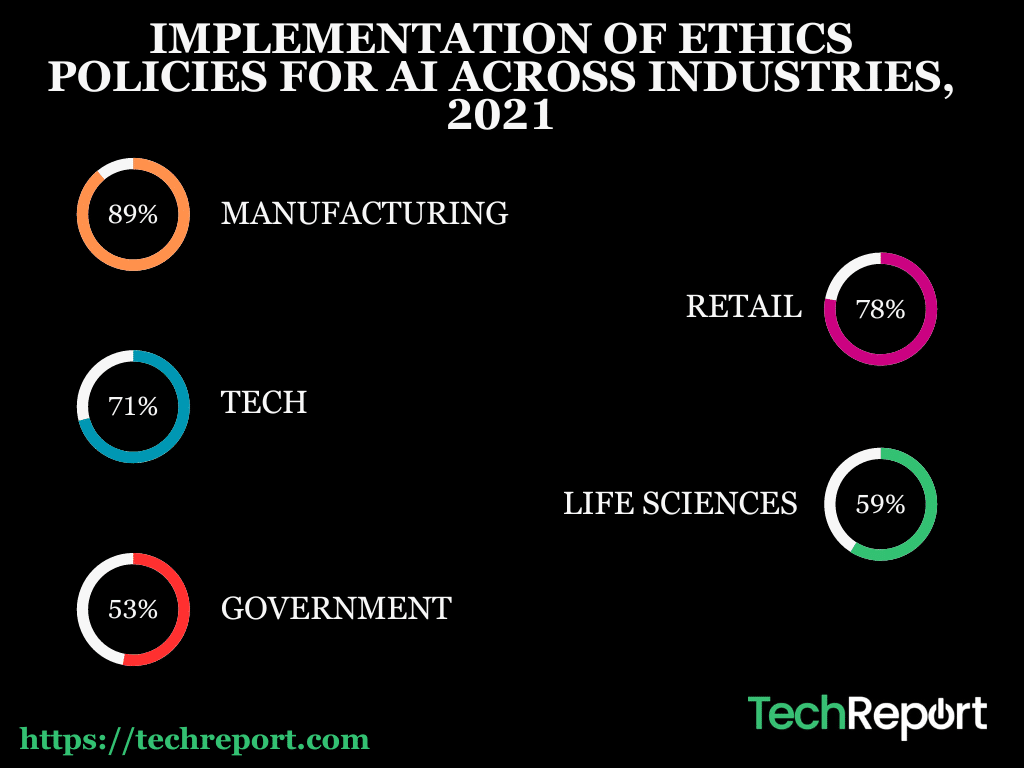
Like this infographic? Feel free to use it on your website or blog, but please remember to give us credit by linking back to techreport.com/statistics/ai-statistics in your post.
As with all innovations, we must approach AI development ethically and responsibly for it to have a truly positive impact on society. And that includes addressing the safety concerns of consumers, 76% of whom are worried about misinformation coming from AI.
To address such concerns, businesses must show that AI is safe. This is achieved through fair and transparent communication and approaches toward AI development. Businesses should also comply with AI standards and the appropriate legislation and should be held accountable.
Having principles of fairness, transparency, and accountability regarding AI use embedded in a business’ stated values and mission statement will make its implementation more widely accepted across the entire organization.
That can be a challenge. However, the issue of AI ethics is being acknowledged more and more, and there are now more than 200 startups offering ethical AI services in partnership with the Ethical AI Governance Group.
AI in Cybersecurity
In 2022, $5.38 billion was invested in AI in cybersecurity. The AI in cybersecurity market is forecast to reach $46.3 billion by 2027, with a CAGR of 23.6%.
This growth isn’t that surprising – advancing cybersecurity threats require an advanced response. In fact, almost 70% of IT executives believe their employer won’t be able to respond to cyber threats without the help of AI, and 48% of organizations in the UK, USA, and Australia will invest in AI for cybersecurity by the end of 2023.
Among other things, AI can help with:
- Automating cybersecurity breach responses
- Continuous threat monitoring and real-time detection
- Flagging suspicious login attempts and improving password management
- Identifying internal malicious actors
- Measuring the effectiveness of other cybersecurity tools
- Predicting breach risks
Enhanced Human-AI Collaboration
The human-AI collaboration trend has emerged as a response to a perceived threat of AI taking jobs. The concept involves humans and AI agents working together to accomplish specific goals.
Scholars and organizations have proposed various Collaborating Humans and AIs (CHA) frameworks. For instance, a 2019 study by Partnership on AI proposed a framework that focused on the nature of collaboration, situation, and context, and characteristics of both the AI system and the humans involved.
The study also explored different collaboration examples, including VAs and users, intelligent tutoring systems, and autonomous vehicles and passengers. By applying the listed main concepts of the framework to these examples, the study attempted to assess best practices for each example.
AI in Business & Finance
As many as 77% of businesses worldwide use AI, with 35% of them using it actively and 42% exploring its use in the future. And given AI’s growth opportunities for automation, customer interactions, and risk management, the only way is up.
84% of C-suite execs believe AI will drive their growth objectives. But what are the potential use cases for AI in business? Let’s take a closer look at AI trends in business and finance.
Automated Data Analysis
The amount of data generated by businesses is growing on a daily basis – in fact, 90% of all data in existence has been generated in the last two years.
But it’s becoming increasingly hard for humans to analyze such huge quantities of data. And that’s where AI-powered data analysis comes in. It can process huge quantities of data quickly and find patterns, forecast trends, and provide valuable insights.
These AI tools can also be instrumental for data aggregation – in fact, 40% of companies use them for that purpose. And according to the British government, AI-powered automated data analysis and management tools are the most popular AI tools for business in the UK. They were adopted by 9% of British companies in 2022.
Risk Assessment & Fraud Detection
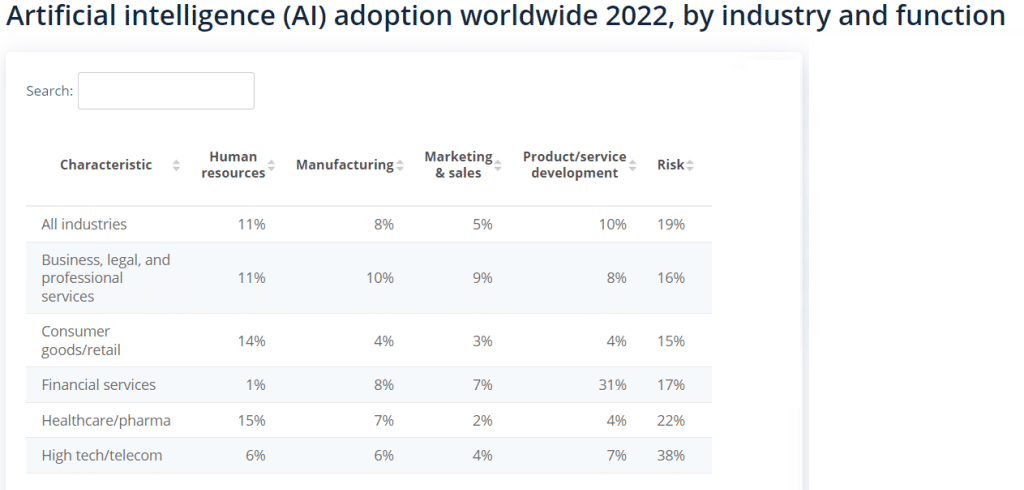
Source: Statista
With AI, your organization is protected from threats 24/7. We mentioned earlier that AI can help mitigate cybersecurity risks with threat detection. But there are also other AI risk assessment applications.
For instance, AI and ML can detect data anomalies indicating fraudulent activity and identify high-risk customers and employees. And when it comes to AI in finance, for example, banks can train their systems to recognize fraudulent transactions and fake users.
The adoption of AI for risk assessment is at its highest in the high-tech industry (38%) and healthcare (22%). The retail industry also values AI for this purpose – 72% of retail execs cited risk management and customer satisfaction as the biggest benefits of AI for business.
CRM
Gartner tells us that customer satisfaction is expected to grow by 25% by 2023 for organizations using AI. That’s particularly true for eCommerce companies, and those with a digital audience – chatbots and online personalizations are two major use cases.
In addition, AI can analyze huge amounts of customer data and preferences, and organizations can use these analytics to offer more personalized experiences to their customers.
Robotic Process Automation (RPA)
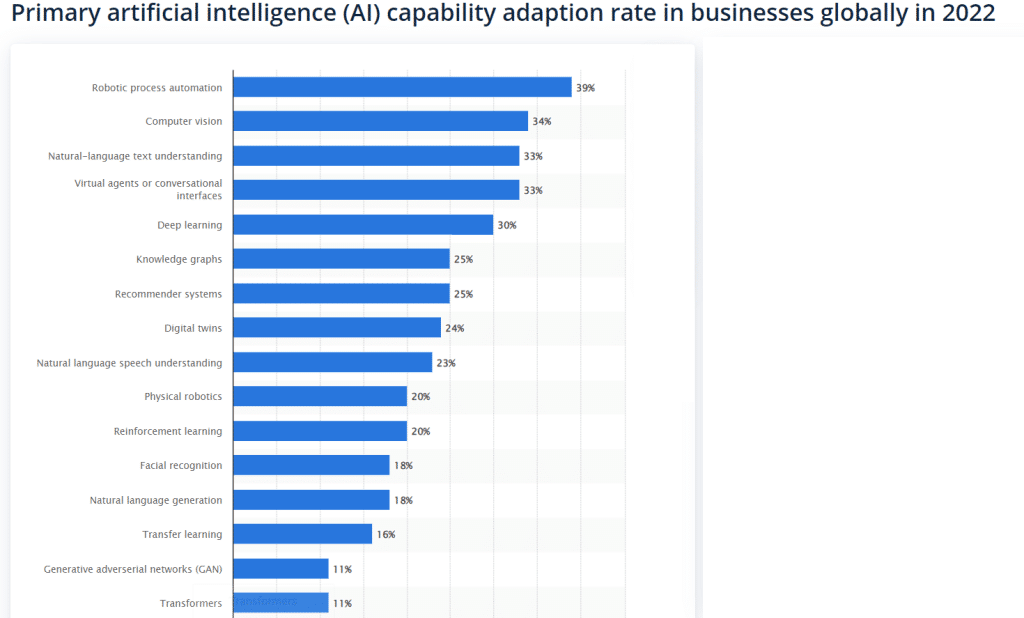
Source: Statista
RPA is a process of automating simple processes via software solutions. When powered by AI, these programs can perform more complex business tasks faster and more accurately, reducing human errors.
The main benefits of using RPA in business are boosting operational efficiency and increasing productivity. And it’s gaining momentum – it’s predicted that the RPA market will reach $43.52 billion by 2029.
AI-Assisted Decision-Making
With as many as 44% of businesses planning to invest in AI in 2023, AI-supported decision-making is on many executives’ minds.
That’s no surprise – AI can analyze huge pools of data, identify patterns, and provide valuable insights to support decision-making. Moreover, AI-assisted decision-making can help reduce the impact of human errors and bias.
AI in Healthcare & Medicine
The AI in healthcare segment received $6.05 billion in funding in 2022 – more than any other segment. It’s perhaps hardly surprising, given that healthcare AI can literally save lives.
The total global market for AI in healthcare and medicine is expected to grow to $102.7 billion by 2028. Let’s take a look at some statistics and trends.
Medical Imaging & Diagnostics
When armed with AI in medical imaging, physicians can identify and diagnose diseases from X–Rays and MRIs much more quickly. If this is combined with large pools of patient data, AI diagnostics decisions are even more accurate and can reduce healthcare providers’ mistakes significantly.
With AI being able to diagnose conditions on the basis of medical imagery, medical professionals’ workloads can be significantly reduced. That’s one of the big reasons why AI medical imaging is on the rise, and the AI-powered diagnostics market is forecast to be worth over $3.8 billion by 2025.
Precision Medicine
Gartner predicts that by 2023, 20% of healthcare organizations will use AI to improve precision medicine. The potential use cases range from genomic data analysis and pattern identification to spotting diseases early and providing personalized treatment plans. This can consequently reduce prolonged hospital stays and healthcare costs.
Drug Discovery & Development
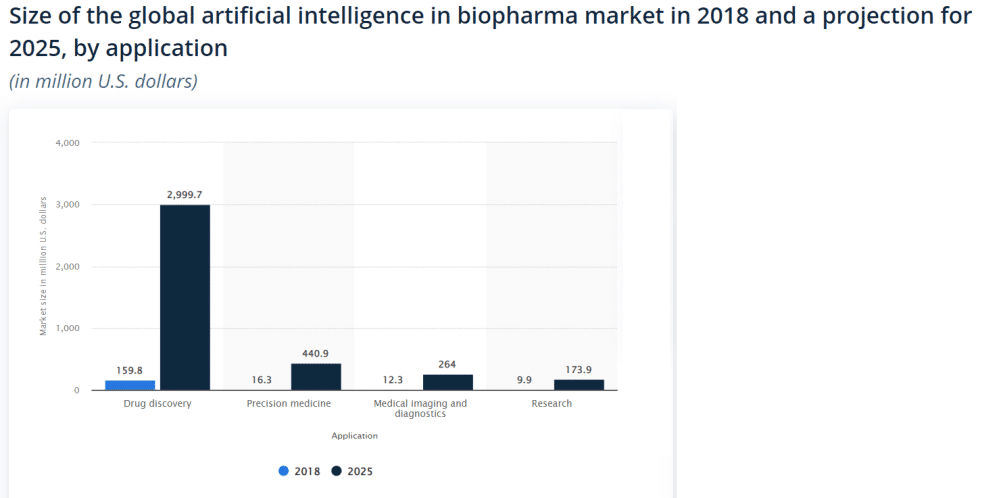
Source: Statista
AI algorithms can analyze huge amounts of data, such as clinical trial results and the molecular structures of substances. This can help identify potential drug candidates and predict their effectiveness and safety.
This, in turn, will allow researchers to optimize their efforts, saving time and resources. AI-powered drug development can be faster and more targeted than traditional research, opening up new possibilities for treatments and improving global healthcare. That’s why the AI-driven drug discovery market is predicted to reach almost $3 billion by 2025.
Remote Patient Monitoring
The development of RPM accelerated during COVID-19, and its market is now forecast to reach $760 million by 2030.
AI in RPM allows providers to monitor patients remotely and provide personalized care based on their data. It can analyze real-time patient data, such as vitals, symptoms, and medication intake, detect early warning signs of deterioration, and alert healthcare professionals of emergencies.
AI-powered RPM enables proactive interventions, reduces hospital readmissions, and improves patient outcomes.
Medical Chatbots & Virtual Assistants
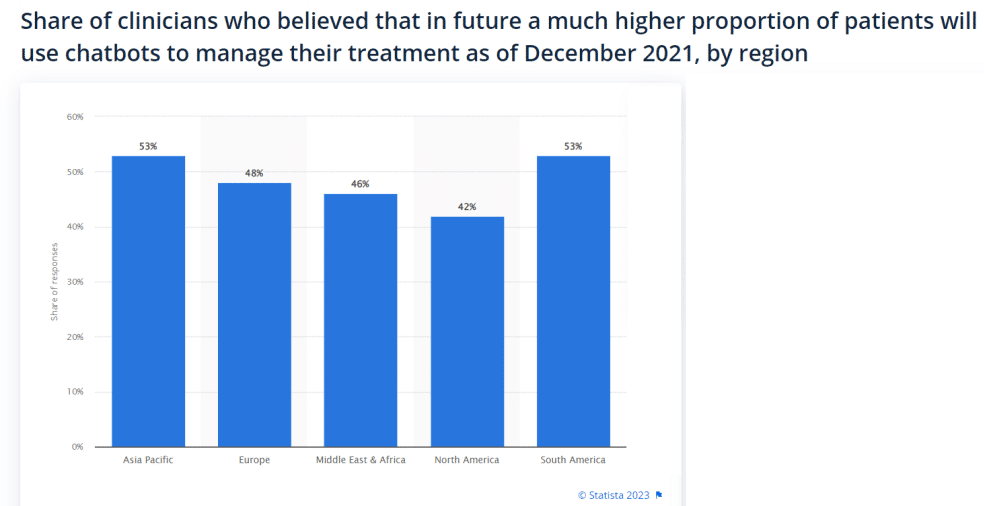
Source: Statista
AI-powered VAs and chatbots can significantly personalize a patient’s experience – whether it’s booking an appointment, checking medication requests, or providing mental health support through a chatbot.
The impact is recognized worldwide, as shown in the chart above, and the market for medical chatbots is predicted to grow to $943.6 million by 2030.
AI in Education & Learning
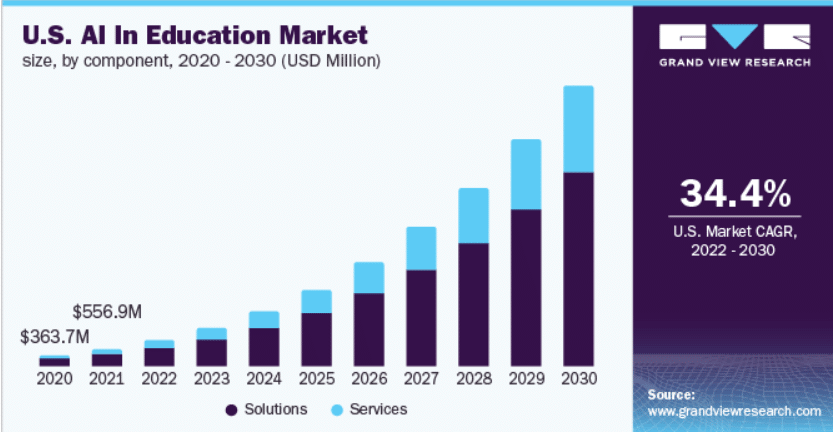
Finally, let’s take a look at AI in education.
As with other segments, AI is disrupting the education sector. For instance, over 47% of learning management tools will be AI-powered within the next 3 years. The AI in education market was valued at $5.4 billion in 2021 and is growing steadily. In fact, it’s expected to expand at a CAGR of 36.14%, reaching $34.58 billion by 2027.
Here are the top AI in education trends.
Personalized Learning
One use case for AI in learning is of delivering learning experiences and support to students in ways that are personalized to them, taking into account their specific needs.
AI algorithms can deliver this by analyzing learning patterns and strengths and weaknesses. This enables adaptive learning pathways, real-time feedback, and personalized assessments, improving student engagement and performance.
Intelligent Tutoring Systems
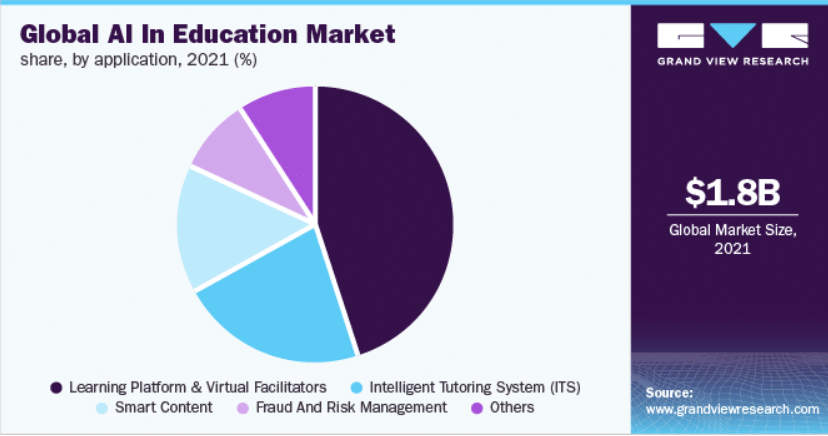
Intelligent Tutoring Systems (ITS) are AI-powered systems disrupting the way students learn and how they master new skills and subjects.
They provide personalized instructions, adapt to students’ learning styles, and offer real-time feedback. In addition, they can analyze performance data, identify areas of improvement, and suggest tailored learning activities. ITS allow students to get customized support, track progress, and achieve better learning outcomes.
Natural Language Processing (NLP) for Language Learning
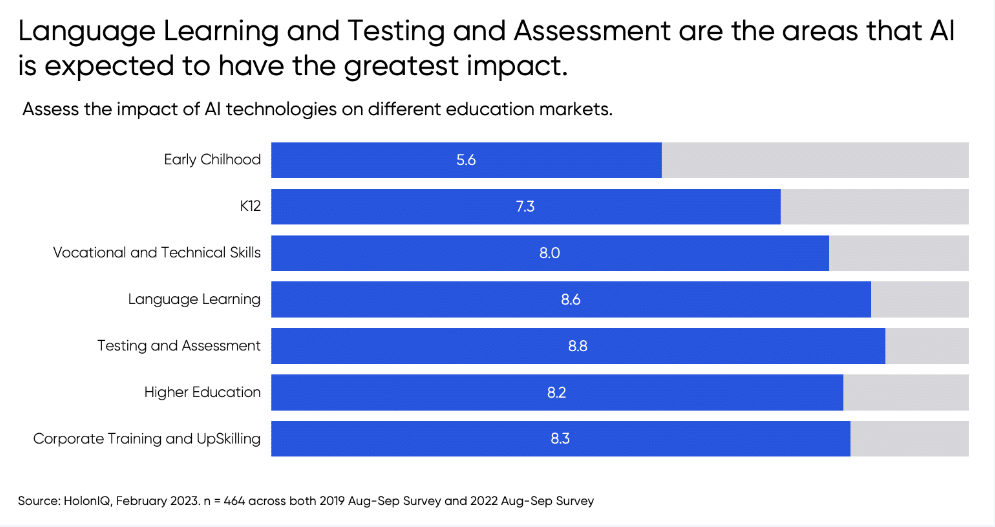
Language learning will be one of the areas most impacted by NLP, according to Holon IQ. That’s not only because of AI’s personalized learning capacities but also due to the benefits provided by various AI tools. For instance, we now have virtual language tutors that are on par with human instructors.
AI can also analyze our speech patterns, identify grammar mistakes, and provide instant feedback. Finally, it can understand the nuances of different languages and help us improve our pronunciation, vocabulary, and grammar.
Automated Grading & Feedback
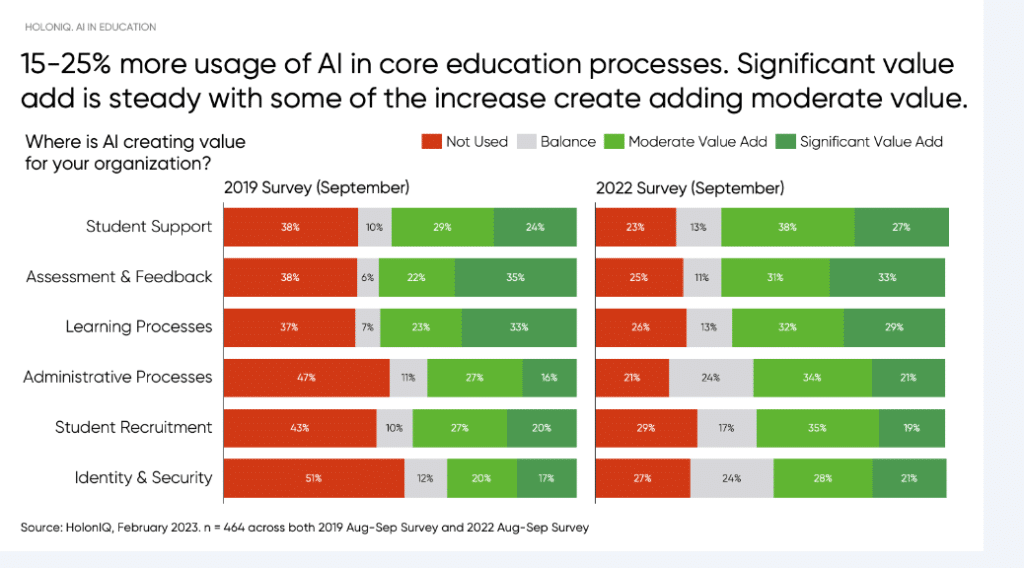
According to studies, 20-40% of teachers’ workloads can be automated with the help of AI. One example of this is in automated grading and feedback, which can reduce grading time by 70%.
Automated grading software can analyze and evaluate students’ work, providing instant, accurate feedback. With AI, teachers can save time on manual grading and focus more on personalized instruction. Additionally, AI-powered feedback helps students identify areas for improvement and learn at their own pace.
Content Recommendation & Adaptive Learning Resources
AI-powered content recommendation and adaptive learning resources play a big part in personalized learning. By crunching huge amounts of data, AI can predict and recommend the perfect content tailored to a student’s interests and learning style.
As a result, the students are more engaged and motivated, and educators get more informed insights into the student’s abilities. And this goes far beyond the educational sector. AI and Instagram engagement are already closely entwined, and we’re only at the dawn of algorithmic content creation and recommendation.
Top Takeaways – Key AI Statistics & Insights
- AI will contribute a 21% net increase to American GDP by 2030
- ChatGPT broke all NLP records by reaching 1 million users in the first five days of its release
- The adoption of AI for risk assessment is at its highest in high-tech industry (38%) and the healthcare industry (22%)
- The total global market for AI in healthcare and medicine is expected to grow to $50.3 billion by 2028
- AI-powered automated grading and feedback can reduce grading time by 70%
AI Isn’t Going Anywhere – But What’s Next?
AI is revolutionizing industry and consumers’ lives on a massive scale, and it isn’t showing any signs of slowing down. It’s already making significant contributions to business, healthcare, and education. However, the increasing adoption of AI raises the question: what’s next?
We must view the future of AI development through the lens of ethical considerations. As we navigate these exciting developments, it’s essential to ensure AI’s responsible development and deployment for the overall benefit of society.
References
- 5 AI Trends Changing Education In 2022 (EDGEucating)
- 69% of organizations believe that they will not be able to respond to cybersecurity threats without AI (Capegemini)
- AI Act: a step closer to the first rules on Artificial Intelligence (European Parliament)
- AI activity in UK businesses: Executive Summary (Gov.uk)
- AI, Data Analytics Star as Biggest Planned Investments for 2023 (Nextgov)
- AI-driven operations forecasting in data-light environments (McKinsey)
- AI in Education Market 2023 Growth, Trend, Share, and Forecast till 2030 (Digital Journal)
- A Local Law to amend the administrative code of the city of New York, in relation to automated employment decision tools (The New York City Council)
- Americans hold mixed opinions on AI and fear its potential to disrupt society, drive misinformation (Ipsos)
- Applications of GPT-3 in Business and Technology (ERAINTERFACES)
- Artificial Intelligence (Accenture)
- Artificial intelligence (AI) in cyber security market value worldwide from 2019 to 2027 (Statista)
- Artificial intelligence (AI) private investment worldwide in 2022, by industry (Statista)
- Artificial Intelligence: Growth Boosting Factor in the New Normal (IoT For All)
- Artificial Intelligence in Education. 2023 Survey Insights (HolonIQ)
- Artificial Intelligence In Education Market size is expected to reach USD 173.39 Bn by 2033 (EnterpriseAppsToday)
- Artificial Intelligence in Healthcare Industry worth $102.7 Billion by 2028 (Markets and Markets)
- Artificial Intelligence Market Size, Share & Trends Analysis Report By Solution, By Technology (Deep Learning, Machine Learning), By End-use, By Region, And Segment Forecasts, 2023 – 2030 (Grand View Research)
- Assessing the potentiality of algorithms and artificial intelligence adoption to disrupt patient primary care with a safer and faster medication management: a systematic review protocol (BMJ Open)
- Big Data and What it Means (U.S. Chamber of Commerce Foundation)
- By 2030, one in 10 vehicles will be self-driving globally (Statista)
- Business benefits of AI according to retail executives worldwide in 2023 (Statista)
- ChatGPT Sprints to One Million Users (Statista)
- Healthcare Chatbot as the Main Trend in the Medical Industry (Glorium Technologies)
- How artificial intelligence will impact K-12 teachers (Mckinsey)
- How is artificial intelligence used in fraud detection? (CoinTelegraph)
- Human – AI Collaboration Framework and Case Studies (Collaborations Between People and AI Systems (CPAIS)
- Fraud Detection with Machine Learning & AI (SEON)
- GPT-4: How Is It Different From GPT-3.5? (Search Engine Journal)
- GPT-4 vs. GPT-3.5: how much difference is there? (DigitalTrends)
- IBM Global AI Adoption Index 2022 (IBM)
- Incremental GDP increase based on impact of artificial intelligence by economic driver in the United States by 2030 (Statista)
- Investment plans of IT and security decision-makers in AI-driven cybersecurity in selected countries worldwide as of January 2023 (Statista)
- Leading challenges of using artificial intelligence (AI) and machine learning (ML) tools according to marketing professionals in the United States as of July 2022 (Statista)
- Medical Imaging AI Market Projected to Reach $1.2 Billion by 2025 (SignifyResearch)
- Natural Language Process worldwide market value from 2020-2028 (Statista)
- Primary artificial intelligence (AI) capability adaption rate in businesses globally in 2022 (Statista)
- Remote patient monitoring aims to transform healthcare by using AI and wearables (MedicalDevice-Network)
- Robotic Process Automation (RPA) Market Size, Share & COVID-19 Impact Analysis (Fortune Business Insights)
- Size of the global artificial intelligence in biopharma market in 2018 and a projection for 2025, by application (Statista)
- The future is now: Unlocking the promise of AI in industrials (McKinsey)
- Top 10 AI Trends That Will Transform Businesses in 2023 (Influencer Marketing Hub)
- Top 18 AI Use Cases in Healthcare Industry in 2023 (AIMultiple)
- Using Artificial Intelligence in Cybersecurity (Balbix)
- Weaving fairness, transparency and ethics into AI (TechNative)
- Why You Need RPA To Reduce Human Error In The Hospitality Sector (Cevitr)






